|
FORT WAGNER
Although black soldiers at Port Hudson and Milliken's Bend had
demonstrated a raw courage and dash that compared with that of the very
best white troops, those fights received such scant coverage and
occurred at such a great distance from the seat of power that they did
not have the impact on the popular mind that many had predicted. Most
northerners in and out of the army needed more convincing. The Union
assault on Fort Wagner provided just such an opportunity.
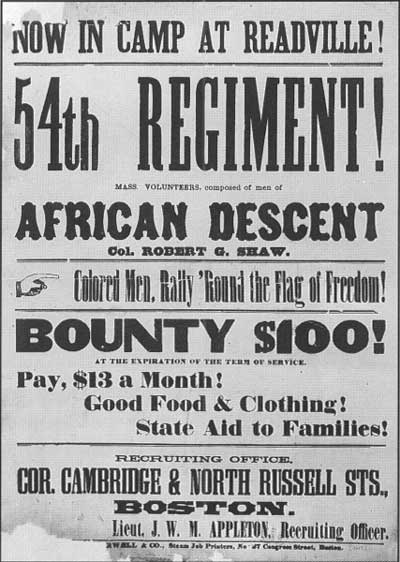
|
AN 1863 RECRUITMENT POSTER. (MH)
|
Few Civil War regiments attracted the interest of the Northern public
as did the 54th Massachusetts (Colored) Infantry. It was the brainchild
of Massachusetts governor John Andrew and the dream of thousands of
blacks and whites throughout the North. Although it was a state
volunteer regiment, a majority of the men in the 54th Massachusetts
actually came from other states. Prominent African Americans throughout
the North worked vigorously to fill its ranks, as the regiment attracted
some of the finest young black men the free states had to offer,
including two sons of Frederick Douglass.
Its officer corps consisted of outstanding young white men. When
Governor Andrew cast around for individuals to command this black
regiment, prior military service and "firm anti-slavery principles" were
mandatory. To locate these men, Andrew searched the educated antislavery
society circles from the prewar years, "which next to the colored race
itself have the greatest interest in the success of this experiment."
From there he plucked Captain Robert Gould Shaw for its colonel and Ned
and Penrose Hallowell as other field officers.
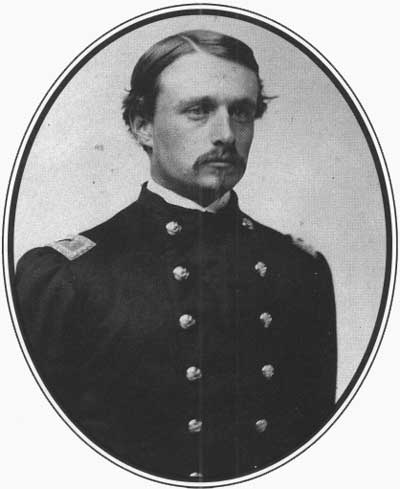
|
COLONEL ROBERT G. SHAW (MH)
|
Andrew received permission to form the 54th Massachusetts at the end
of January 1863, and from that moment a mass of nearly one thousand
black civilians transformed rapidly into a regiment of soldiers. Within
a few' months the ranks filled, and by the end of April authorities
issued the men Enfield rifled muskets. They trained rigorously just
outside Boston, at Readville, and there Andrew presented the regiment
with its flags. With the troops in line and dignitaries in attendance,
Andrew announced to Colonel Shaw, "I know not, Mr. Commander, when, in
all human history, to any given thousand men in arms there has been
committed a work at once so proud, so precious, so full of hope and
glory as the work committed to you." Ten days later they paraded through
Boston as huge crowds lined the streets to cheer. Then they boarded a
steamer bound for the South Carolina coastal islands, and by early June
they were in the war zone.
Before the attack on Fort Wagner, the 54th Massachusetts had gained
limited experience. It participated in a raid on Darien, Georgia, that
resulted in the burning of the town. Even though it was an unwilling
participant in the conflagration, the affair was an embarrassment for
the entire regiment. Shortly afterward, while other Federals slipped
ashore at Morris Island in quest of the prized Fort Wagner, the 54th
Massachusetts helped to lead a feint on adjacent James Island. When
Confederates launched a night attack, men in the 54th Massachusetts held
the line long enough for soldiers in the 10th Connecticut Infantry to
retreat and for reinforcements to advance to the front. As one of the
Connecticut troops penned to his mother, "But for the bravery of three
companies of the Massachusetts Fifty-fourth (colored), our whole
regiment would have been captured. As it was, we had to double-quick in,
to avoid being cut off by the rebel cavalry. They fought like
heroes."
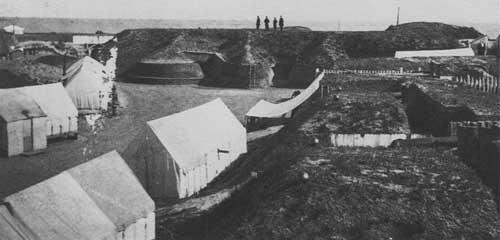
|
A VIEW OF THE INTERIOR OF FORT WAGNER. (MH)
|
Meanwhile, Shaw had been scheming to participate in the upcoming
fight at Fort Wagner. He wrote to Brigadier General George C. Strong, a
West Point graduate from Massachusetts, telling him how much the
officers and men desired a prominent role in the campaign against Fort
Wagner. When Strong's brigade received the assignment to lead the
assault on Fort Wagner, its commander requested the transfer of the 54th
Massachusetts, fresh from its outstanding performance on James Island,
to head the attack.
Although Strong and the officers and men of the 54th Massachusetts
regarded the offer as an honor, division commander Major General Truman
Seymour assented to the request for another reason. The black troops
were expendable. Speaking to operations commander Major General Quincy
A. Gillmore, and overheard by a journalist, Seymour confided, "Well, I
guess we will let Strong lead and put those d—d niggers from
Massachusetts in the advance; we may as well get rid of them one time as
another."
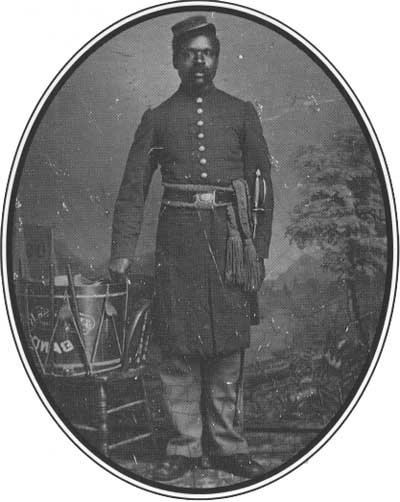
|
WILLIAM J. NETSON OF THE 54TH MASSACHUSETTS. (MH)
|
Fort Wagner rested near the northern tip of Morris Island. The
bastion was valuable because it protected Battery Gregg, at the very
edge of Morris Island and overlooking the entrance to Charleston Harbor.
With Battery Gregg in Federal hands, they could shell Fort Sumter in the
middle of Charleston Harbor into capitulation, which would close the
harbor completely to Confederate blockade runners and pave the way for
an attack on Charleston.
Seventeen hundred troops and seventeen artillery guns defended the
fort from all directions. They swept the southern approach superbly. For
added insurance, the Confederates had prepared a moat three feet deep
just outside the first wall and a rifle pit two hundred yards beyond
that.
Early in the evening of July 18, the 54th Massachusetts, composed of
630 officers and men, arrived at Strong's headquarters. For much of the
last two days the regiment had been in motion, and the troops had eaten
nothing since breakfast. Nevertheless, Strong merely fed them some words
of encouragement and pushed them forward.
The plan called for the black troops to strike first, succeeded by
regiments from Strong's brigade. In the event these troops did not carry
the works, Seymour had two more brigades to throw into the fight, but he
viewed them as a precaution. The Federal high command anticipated a
swift success. They greatly underestimated the strength of Fort Wagner
and the size of its garrison.
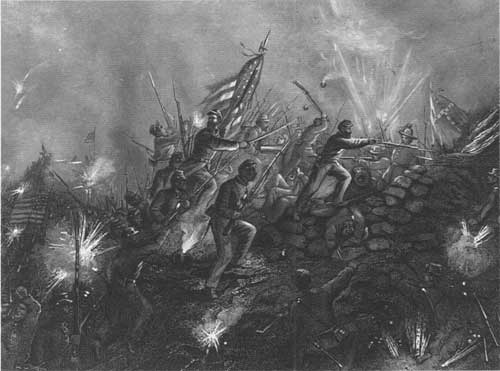
|
THE ATTACK ON FORT WAGNER. (LC)
|
Shaw planned to have his regiment attack in column in two waves, five
companies across his front. Once they got in position with his right
flank on the edge of the surf, approximately one mile from Fort Wagner,
he had the men lie down to give other regiments a chance to get in
position.
When it appeared that succeeding regiments were nearly in place,
Strong rode up to give some parting words. "Don't fire a musket on the
way up," he warned, "but go in and bayonet them at their guns." He then
asked who was going to carry the regimental flag if the color-bearer
fell, and Shaw, removing a cigar from his clenched teeth, replied
calmly, "I will," to the delight of the men.
As Strong galloped away, Shaw began to wander up and down the lines
and spoke briefly to his troops. In an affectionate tone that surprised
the troops, the soft-spoken commander simply called upon the soldiers of
the 54th Massachusetts that day to "prove themselves as men." Like his
troops, Shaw had a fair inkling of the hazards of the attack. Moments
earlier, he had divested himself of some personal items to a civilian
acquaintance to send to his family in the event of his death.
After a wait that seemed interminable, Shaw cried out, "Boys, are you
ready to take that fort?" Shouts of "Yes! Yes!" resounded as they began
the fateful advance. Shaw elected to lead the left wing personally and
positioned himself next to the regimental flag, while Lieutenant Colonel
Ned Hallowell directed the men on the right.
Confederate batteries on adjacent islands opened fire as soon as they
observed the advance, but the troops at Fort Wagner waited until the
black troops packed tightly into the pocket between the swamp and ocean.
Suddenly, powder flashes lit up the wall and Confederate shot and shell
tore huge gaps in the Federal columns. "Not a man flinched," wrote
survivor Sergeant Major Lewis Douglass, "though it was a trying time. A
shell would explode and clear a space of twenty feet, our men would
close up again."
All the while Confederates poured shot and shell into the rushing
Federal ranks. Yet the black soldiers pushed on intrepidly. Despite
sustaining heavy casualties, they increased speed until they were on a
dead ruin. Through the waist-deep ditch the columns swept, and in
moments the bluecoats clambered up the outer embankment. Some
Confederate troops now came out from their protection and lowered their
aim to strike down the black attackers as they mounted the first
slope.
In the race for the fort, Shaw swung past the salient in the
southeastern corner and drove directly into the center, where
Confederates blazed away at the attackers from three directions.
Positioned at the head of the assault, he miraculously reached the Rebel
works. Witnesses said he had sustained several wounds but refused to
yield. As Shaw reached the top, he urged the men forward, sword swirling
above his head. A ball then crashed into his chest and toppled him
backward dead.
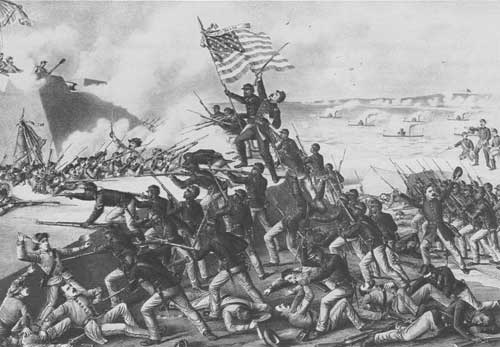
|
THIS PERIOD LITHOGRAPH SHOWS THE STORMING OF FORT WAGNER AND THE FATAL
WOUNDING OF COLONEL SHAW (LC)
|
Despite the loss of the regimental commander, the color-bearer
planted the flag on the parapet and some black soldiers penetrated into
the Confederate works. Thrusting with bayonets and clubbing with rifle
butts, Shaw's troops battled the defenders hand-to-hand. They were no
match for the superior Confederate numbers. Overwhelmed from three
directions, the Federal attackers quickly exhausted their strength and
fell back outside the inner wall. There Confederates began dropping hand
grenades and lighted shells on the assailants.
On the right, Hallowell went down with a severe groin wound, but a
small portion of his men struck the fort in the southeast corner. There
some unnerved Rebels abandoned their defenses, and for a moment it
seemed that the first assault might succeed. Just as suddenly, though,
Confederate reinforcements arrived to drive back the attackers. Had Shaw
concentrated on this portion of the Confederate line, the outcome of the
battle might have been more in doubt, but the Federals here were too few
in number to make a difference.
Nor did Strong's brigade affect the outcome of the battle. His
supporting blue columns were too slow in the attack. By the time they
arrived on the scene, the Confederates had completely repulsed the
assault of the 54th Massachusetts. Their fate was similar to that of
Shaw's regiment, without such severe losses.
Those survivors in the 54th Massachusetts who were able to retreat
began to fall back across ground littered with scores of their black
comrades. The 9th Maine Infantry, whipped into a frenzy in anticipation
of the assault, began pouring lead in the direction of the fort and
felled "a great many" men in the 54th Massachusetts, according to a
black survivor. It took the intervention of some New York troops to
check the friendly fire.
Several hundred yards to the rear, a junior captain took over the
reigns as temporary regimental commander. All he could do was collect
these men and place them in rifle pits where they fired over the bodies
of comrades in support of other Union troops who joined the attack.
As night fell, some men in the 54th Massachusetts crawled away or
bolted across the open ground and managed to return to Federal lines.
One of those men was Sergeant William H. Carney, who snatched the
national flag when its bearer fell and planted it on the Confederate
works. There be sustained a wound in each leg, one in the chest, and
another in the right arm, yet Carney managed to carry the flag back in
retreat.
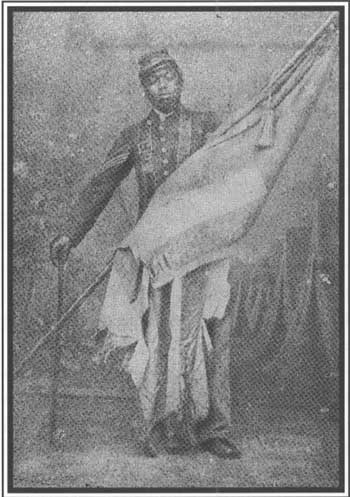
|
SERGEANT WILLIAM H. CARNEY RECEIVED THE MEDAL OF HONOR FOR HIS
PARTICIPATION IN THE BATTLE OF FORT WAGNER. (USAMHI)
|
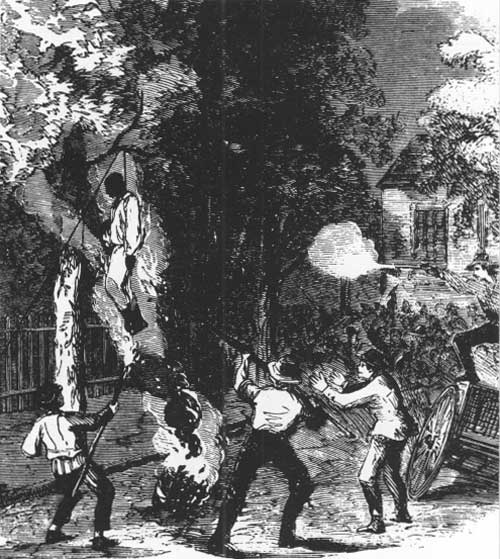
|
A BLACK MAN IS HANGED IN THE STREETS OF NEW YORK DURING THE DRAFT RIOTS.
(HARPER'S WEEKLY)
|
Others who refused to run the gauntlet or had suffered wounds became
prisoners of war. Among them was Sergeant Robert J. Simmons, whose arm
was shattered by a Rebel ball. Unknown to Simmons, three days earlier in
New York City a draft protest had turned into a race riot, and a mob had
terrorized his mother and sister and stoned and clubbed to death his
seven-year-old nephew. In one of the great tragedies of the war Simmons
had his arm amputated and died several weeks later in a Charleston
hospital, representing the very same people who murdered his young
nephew.
Well over 40 percent of the men in
the 54th Massachusetts were casualties in the assault on Fort Wagner. As
one soldier described it, "They mowed us down like grass."
|
Well over 40 percent of the men in the 54th Massachusetts were
casualties in the assault on Fort Wagner. As one soldier described it,
"They mowed us down like grass." Confederate officials sent the wounded
to Charleston hospitals, and after considerable indecision the prisoners
of war went to camps, where some died and others were exchanged.
The Confederates interned the bodies of two officers in separate
graves, but they laid Shaw to rest in a pit with his men. When Union
authorities tried to retrieve his remains under a flag of truce, a
Confederate hollered back indignantly, "We have buried him with his
niggers!" Clearly the Confederates had intended to insult the
sensibilities of whites; instead, it became a rallying cry across the
North and helped to immortalize Colonel Robert Gould Shaw.
One month later, when Shaw's father learned that General Gillmore was
attempting to secure the remains, he requested that his son's body lie
with his men. "We hold that a soldier's most appropriate burial-place is
on the field where he has fallen," the elder Shaw explained.
No doubt, the Battle of Fort Wagner left a lasting mark on its black
participants. Two weeks after the assault, a black sergeant wrote his
company commander, at home recuperating from a wound, "I still feel more
Eager for the struggle than I ever yet have, for I now wish to have
Revenge for our galant Curnel and the spilt blood of our Captin. We
Expect to Plant the Stars and Stripes on the Sity of Charleston." Rather
than undercut their commitment to the cause, the defeat at Fort Wagner
enhanced the desire of the men in the 54th Massachusetts to see the war
through to its successful conclusion. Two months after the valiant
effort of the 54th Massachusetts, the Confederates evacuated Fort
Wagner.

|
PRIVATE ABRAHAM F. BROWN OF THE 54TH MASSACHUSETTS. (MH)
|
In conjunction with the outstanding performance of black soldiers at
Port Hudson and Milliken's Bend, the assault on Fort Wagner challenged
contemporary racial stereotypes. Black soldiers had demonstrated a
willingness to stand up and fight against the Confederacy, something few
Northern whites had considered possible. In turn, this helped to lay the
foundation for the tremendous expansion of the number of black men in
military service over the next two years. Prejudice was too deeply
rooted for the Northern white population to cast it aside, but the
blacks' conduct in these battles impressed them enough to give serious
consideration to the widespread use of black soldiers. Slowly yet
steadily, the Northern public began to warm to the idea that black
soldiers could contribute significantly to the war effort. If the black
troops had misbehaved under fire in these three battles, the results
would have been catastrophic for the black soldiery and the black race.
Fortunately, they fought with the courage of veterans, and that opened
the door for others to serve.
Some eight months after the assault on Fort Wagner, the 20th U.S.
Colored Infantry, raised throughout New York, paraded through the
streets of New York City, the same place where a mob had murdered
Sergeant Simmons's nephew. Now, thousands of people, both white and
black, lined the avenues to cheer these men in Union blue. In part the
draft had made the enlistment of black soldiers more acceptable to
whites because blacks filled manpower quotas as did whites. But there
was more to it than that. Whites had come to realize that these one
thousand black soldiers were fighting for the same government and causes
as were white troops.
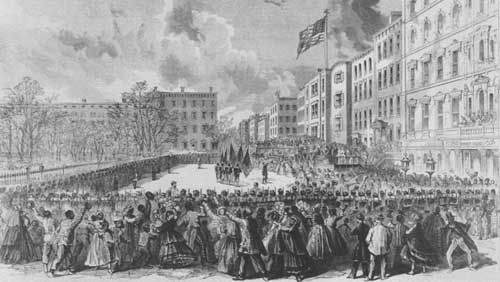
|
THE PRESENTATION OF COLORS TO THE 20TH UNITED STATES COLORED INFANTRY IN
NEW YORK CITY. (FW)
|
The change in Northern attitudes, noted the New York Times,
was startling:
Eight months ago the African race in this City were literally hunted
down like wild beasts. They were shot down in cold blood, or stoned to
death, or hung to the trees or to the lamp posts. . . . How
astonishingly has all this been changed! The same men who could not have
shown themselves in the most obscure street in the City without peril of
instant death, even though in the most suppliant attitude, now march in
solid platoons, with shouldered muskets, slung knapsacks, and buckled
cartridge boxes down through the gayest avenues and busiest
thoroughfares to the pealing strains of martial music, and everywhere
are saluted with waving handkerchiefs, with descending flowers, and with
the acclamations and plaudits of countless beholders.
|
